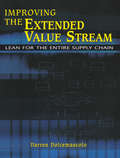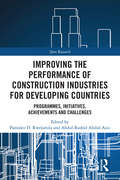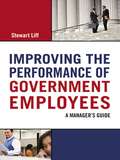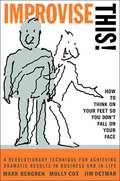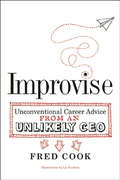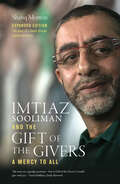- Table View
- List View
Improving the Efficiency of R&D and the Market Diffusion of Energy Technologies
by Bernd Ebersberger Sascha Ruhland Eberhard Jochem Jakob Edler Clemens Cremer Harald Bradke Peter Radgen Wilhelm Mannsbar Frank Marscheider-Weidemann Alexandra Krebs Carsten Dreher Oliver SomIs there a chance that public or private research and development institutions can improve the efficiency of the R&D process? This book gives a positive answer by designing an integrated concept of the science technology cycle and the innovation system of each technology. The position of a new technology in the sciencetechnology cycle is identified by several indicators from patent analysis, citations and market information data. The innovation system supports the search for a comprehensive understanding of all important stakeholders of an innovation, possible obstacles and related policies. The application of the methodology leads to convincing results: the hype of the PEM fuel cell activities could have been identified at the end of the 1990s as the phase of euphoria, but not as a situation close to market entry in the car or boiler markets.
Improving the Energy Performance of Buildings
by Charles P. Ries Oliver Wise Joseph JenkinsThis study examines how policies to increase energy efficiency in buildings in the European Union and Australia have worked and draws implications for the design of similar public policies for the United States. It appears that effective policies to promote energy efficiency can be devised using information disclosure, building codes, financial incentives, and benchmarking. Insights are presented to help designers of analogous U.S. policies.
Improving the Evaluation of Scholarly Work: The Application of Service Theory
by Michael Saren Evert Gummesson Montserrat Díaz-MéndezThis book aims to stimulate debate in the growing and highly controversial area of measuring scholarly work. The authors examine key aspects of this topic through the lens of the latest theoretical developments in service science and associated fields. It includes chapters explaining the theoretical developments and methodological aspects of measuring the quality of academic teaching and research, while other chapters provide a review and analysis of various types of scholarly work metrics and processes with examples from several countries, cultures, and educational systems. The current growing concern about higher education (HE) quality has prompted institutions to divide university teachers’ work into different areas and to design methods aimed at measuring the productivity of these areas. It is widely accepted that the need to evaluate HE service quality is a relevant issue for any society. However, the authors argue that most of the current practices used in the pursuit of this objective are jeopardizing the future of the university as a place of knowledge generation, science evolution and professional education.
Improving the Extended Value Stream: Lean for the Entire Supply Chain
by Darren DolcemascoloThis book discusses a system for extending lean manufacturing across the entire supply chain. It is divided into three parts: planning and analysis of the lean extended value stream, implementation of a lean supply chain and sustaining and continuously improving the lean extended value chain.
Improving the International Monetary System
by Morris Goldstein Tamim Bayoumi Donald J. Mathieson Michael Mussa Peter B. ClarkThis study addresses major policy issues associated with the future of the international monetary system. It focuses on whether there is a need for fundamental reform of this system, defined as systematic and sustained effort on the part of the three major industrial countries (United States, Japan, and Germany) to maintain their exchange rates within agreed ranges. It then discusses less rar-reaching reforms that could strengthen and improve the system.
Improving the Measurement of Consumer Expenditures
by Thomas F. Crossley John Sabelhaus Christopher D. CarrollRobust and reliable measures of consumer expenditures are essential for analyzing aggregate economic activity and for measuring differences in household circumstances. Many countries, including the United States, are embarking on ambitious projects to redesign surveys of consumer expenditures, with the goal of better capturing economic heterogeneity. This is an appropriate time to examine the way consumer expenditures are currently measured, and the challenges and opportunities that alternative approaches might present. Improving the Measurement of Consumer Expenditures begins with a comprehensive review of current methodologies for collecting consumer expenditure data. Subsequent chapters highlight the range of different objectives that expenditure surveys may satisfy, compare the data available from consumer expenditure surveys with that available from other sources, and describe how the United States's current survey practices compare with those in other nations.
Improving the Performance of Construction Industries for Developing Countries: Programmes, Initiatives, Achievements and Challenges (Spon Research)
by Pantaleo D. Rwelamila; Abdul-Rashid Abdul-AzizThis book documents the experiences, development, and prospects of the construction industry in numerous developing countries. It will provide a strong base of reference for countries looking to improve their construction industries as part of their wider economic development programme. The opening chapter presents a strategic overview of the contents of the book, and each country-specific chapter is structured to consider the legal and policy frameworks, administrative infrastructure and procedures, and implementation mechanisms, as well as the experiences, current activities, and future plans and programmes with respect to construction industry development in each country. The concluding chapter looks forward and considers the implications of future trends for the construction industries in developing countries and the actions which will be required to address them. Chapters cover: India, Singapore, Chile, South Africa, Tanzania, Malaysia, Botswana, Ghana, Uganda, Indonesia, China, Croatia, and Eswatini. Readers will learn about the wealth of comparable stories from global coverage from the detailed country-specific cases. Building on important scholarly works in the field, this book is essential reading for academics, researchers, and policy makers in built environments, economics, construction management, infrastructure management, and the wider construction industry.
Improving the Performance of Government Employees: A Manager's Guide
by Stewart LiffWith public scrutiny intensifying every day, optimizing the performance of government employees and departments is more critical than ever before. And just as in the private sector, the key for managers is to understand how different management systems perform individually and interact with one another. This book examines the roles and challenges of structural and technical systems, information and decision-making processes, rewards systems, and human capital management, and shows managers how to: deliver clear and consistent messages to all employees; position employees and units to provide the best possible service to the public; hold them accountable through clear expectations and measurable goals; work with a strong leadership team to maintain, adjust, and improve all procedures. Liff devotes a chapter to each system and discusses its impact on overall performance as well as how to work proactively and innovatively to implement changes that will make a big difference. Including real-world government case studies demonstrating dramatic change, the book is both an inspiration and a blueprint for substantial improvement within every facet of government work.
Improving the Performance of Sponsorship
by Ardi KolahWithout a doubt, sponsorship is one of the most powerful promotional tools we have in the business of brand creation, brand recognition, and ultimately increasing sales. Moreover, brokering sponsors is a significant business in and of itself, something we often overlook. Considering sponsorship is a $50 billion a year market--and growing--marketers and students of business ignore its potential at the risk of missing hugely lucrative opportunities. To fail to understand sponsorship is to fail to understand marketing. If you're looking for an introduction to this topic, most books available only address sports sponsorship: the largest section of the market perhaps, but by no means the only one. Kolah's Improving the Performance of Sponsorship is a guide that examines all types of sponsorship, clearly explaining and defining its mechanics, advising on how to select the right properties, how to sell sponsorship, ethical issues, measurement and key legal principles. This book is all keen marketers will need for a thorough understanding of how sponsorship works.
Improving the Product Development Process at Kirkham Instruments Corp.
by Clayton M. ChristensenDescribes the efforts of a manufacturer of scientific instruments to implement new methods of managing new product development, which its executives had learned in a Harvard Business School seminar. The executives left the seminar excited to implement a new way of working, but, through a series of seemingly logical steps, got little accomplished.
Improving the Quality of East and West European Public Services
by Elke L�erThis volume provides a comprehensive overview of current reforms in public sector quality management in Eastern Europe. Comparisons are made with trends in Western European countries to draw out the lessons emerging from current developments (including e-governance). Case studies from twelve countries and five comparative and conceptual studies identify how quality is put into practice, how the level of quality is assessed through quality accreditation systems and how e-government and citizen involvement may help to improve public service quality. The findings make essential reading for academics and students in public policy and public administration who are interested in modernization of the public sector from an international perspective. It also provides helpful guidance for reformers who want to try new approaches to improving the quality of public services.
Improving the Social Security Disability Decision Process: Interim Report
by Institute of Medicine of the National AcademiesThe National Academies Press (NAP)--publisher for the National Academies--publishes more than 200 books a year offering the most authoritative views, definitive information, and groundbreaking recommendations on a wide range of topics in science, engineering, and health. Our books are unique in that they are authored by the nation's leading experts in every scientific field.
Improving the Sustainable Development Goals: Strategies and the Governance Challenge (Routledge Focus on Environment and Sustainability)
by Lars NiklassonImproving the Sustainable Development Goals evaluates the Global Goals (Agenda 2030) by looking at their design and how they relate to theories of economic development. Adopted unanimously by the member states of the United Nations (UN) in 2015, the goals are remarkable for the global commitment on a set of targets to reach by 2030, but also for the lack of a strategy of implementation. The choice of appropriate action is handed over to individual governments, some of which are limited by their lack of resources. This book explores how implementation of the sustainable development goals (SDGs) can be developed, especially in developing countries. The content, strengths and weaknesses of the SDGs are critically examined, alongside their relationship to ongoing academic research. The authors also investigate the actions of governments over the past three years by looking at the national strategies they have presented at annual meetings of the UN High-Level Political Forum. Improving the Sustainable Development Goals takes a critical but constructive approach, pointing out risks as well as possible remedies. The SDGs are seen as an opportunity for a global conversation on what works in solving some fundamental problems relating to poverty and environmental degradation. With the inclusion of a chapter by Tobias Ogweno, former member of the Kenya’s UN mission, this book will appeal to all those who are interested in policy analysis with a focus on development issues.
Improvise This!: How to Think on Your Feet so You Don't Fall on Your Face
by Mark Bergren Molly CoxBusinesses are sending their top managers to improvisational classes to learn how to give presentations, how to talk to clients, and how to finesse difficult situations. But those same skills can be mastered with the help of the simple and fun exercises found in this book. The authors explain how improvisation comes into play in our daily lives, and the rewards of taking risks in those situations. Improvise This! is filled with true-to-life business scenarios and offers methods for not only surviving but triumphing in those situations, making this a valuable and entertaining resource.
Improvise: Unconventional Career Advice from an Unlikely CEO
by Fred Cook&“An entertaining education on leadership, creativity, business and getting ahead of your competition . . . your career will never be the same.&” —The Edge, PRSA blog This year alone, 3.2 million U.S. students will graduate from college. Unprecedented percentages of them will move back home, and many will be unable to obtain a job in their fields of study. Improvise is an inspiring story of how Fred Cook followed an unusual yet fascinating path from young adulthood to the corner office as CEO of the award-winning PR firm GolinHarris. Melding learnings from a lifetime of uncommon experiences with insights from a surprisingly successful corporate career, this book will inspire workers mired in indecision and dimly lit prospects. Following college, Cook was initiated into the business world through a dozen odd jobs, each of which provided valuable insights into the business world and the understanding of how to make the most of even the smallest opportunity. Each chapter delivers a bold truth, supported by relevant episodes from Cook&’s personal life and reinforced by his encounters with corporate America. Filled with colorful anecdotes about being punched by a guru, stalked by an intern, and lectured by Steve Jobs, Improvise is full of hilarious yet poignant moments. &“Fred is a legend in the PR business . . . [Improvise] is immensely fun and engaging.&” —Forbes &“An offbeat career guide for new college graduates.&” —Parade &“Fred shares the street smarts he gained from a lifetime of uncommon experiences to educate and inspire others who are trying to find their own way in the business world.&” —Execunet.com
Impulse für das Marketing im New Normal: Was wichtig bleibt, was wichtiger wird – ein Überblick (essentials)
by Veit Etzold Florian PfänderDieses essential gibt einen kompakten Überblick darüber, was Marketingorganisationen im New Normal beachten müssen. Denn unzählige neue Anforderungen innerhalb der VUCA-Welt haben die Gesetzmäßigkeiten des wirtschaftlichen Miteinanders zwischen Unternehmen und ihren Kunden maßgeblich verändert und die Coronakrise ist hier als beispiellose Entwicklung zu sehen.Dies lässt Unternehmen mit vielen Aufgaben zurück, vor allem müssen die Komponenten Markt- und Kundenorientierung im Rahmen der Marketingstrategie neu gedacht und zeitgemäße strategische Leitplanken zwecks Kundenbindung entwickelt werden. In Zeiten des Wandels und der Krisen bedarf es nun neuer Sichtweisen für die Aufgaben von Morgen, um die eigene Marketingstrategie in einer zunehmend komplexer werdenden Welt noch krisenfester zu gestalten.
Impulse su crecimiento: Un plan de mejoramiento de 90 días (JumpStart)
by John C. Maxwell¿PUEDE CAMBIAR SU VIDA REALMENTE EN 90 DÍAS? John Maxwell dice que la respuesta es sí. En esta guía de 90 días, él comparte los secretos para maximizar su potencial personal y profesional, basada en su éxito de ventas número uno del New York Times, Las 15 leyes indispensables del crecimiento. En esta práctica guía, él le ayuda a impulsar su crecimiento mediante la exploración de sus puntos fuertes, la identificación de sus objetivos, y el desarrollo de los hábitos que impactarán positivamente en su futuro. Cada lección diaria ofrece un conocimiento, inspiración e instrucción, con indicaciones para la aplicación y la acción, y espacio en blanco para documentar el progreso que va obteniendo en su travesía. Ya sea que usted está comenzando una nueva etapa, trabajando hacia esa gran promoción, o deseando un mayor sentido de logro personal, IMPULSE SU CRECIMIENTO le dará los recursos para convertirse en la persona que estaba destinada a ser. Derivado del contenido previamente publicado en Las 15 leyes indispensables del crecimiento
Impulse su liderazgo: Un plan de mejoramiento de 90 días (JumpStart)
by John C. MaxwellJohn C. Maxwell, #1 New York Times bestselling author, presents his 90-day guide to improving your leadership. Whether you want to increase your influence, prepare yourself for that big promotion, or get a handle on leadership for the first time, you can trust John Maxwell to help you in the journey. JumpStart Your Leadership will give you the insight, inspiration, and instruction you need to see tangible improvement in your leadership skills in ninety days. Maxwell gives you clear leadership principles, prompts you to examine yourself, and provides actionable step to help you become the leader you've always wanted to be. And there is space for you to take notes and document your journey. Maxwell says, "Leadership develops daily, not in a day." This portable volume will give you the tools to develop as a leader and activate your leadership potential. Derived from content originally published in The 5 Levels of Leadership
Impulse su pensamiento: Un plan de mejoramiento de 90 d¿as (JumpStart)
by John C. MaxwellJohn C. Maxwell, la autoridad no. 1 en liderazgo en los Estados Unidos con sobre 25 millones de libros vendidos 90 días para convertirse en un mejor pensador... Es un compromiso que puede cambiar su futuro. El autor de éxitos de ventas no. 1 del New York Times John C. Maxwell, describe los secretos para maximizar su potencial de pensamiento en esta guía de 90 días de modo que pueda alcanzar sus metas. A través de lecciones diarias, preguntas que hacen reflexionar y ejercicios para estimular su mente, Maxwell le ayuda a entender y desarrollar la habilidad de pensamiento que comparten todas las personas exitosas. Comenzar esta jornada revolucionará su manera de pensar, equipándole con las herramientas necesarias para comprender y desarrollar la estrategia mental de las personas exitosas. Ya sea que aspire a dirigir, ande en busca de una ventaja o desee romper barreras en su carrera; el consejo en este libro le ayudará a llegar donde desea ir. El éxito comienza en su mente. Es hora de que IMPULSE SU PENSAMIENTO.
Impulse sus prioridades: Un plan de mejoramiento de 90 días (JumpStart)
by John C. MaxwellIn this 90-day growth guide, #1 New York Times bestselling author John C. Maxwell helps you prioritize your life to make each day count toward fulfilling your goals. Based on his Businessweek bestseller Today Matters, John Maxwell offers his roadmap for success by helping you seize the present. The way you prioritize and spend your time each day impacts your ability to reach your goals. Whether you are a new leader or looking to expand on your success, this book will help you focus by exploring how to maximize the potential of the most important day of your life--today. Offering inspiring quotes and lessons, thought-provoking questions, and space for reflective notes, over the course of three short months this book will help learn to master the moment and set you on the path toward fulfilling your aspirations.
Impulsgeber Luftfahrt: Industrial Leadership durch luftfahrtspezifische Aufbau- und Ablaufkonzepte
by Martin Hinsch Jens OlthoffDie Luftfahrtindustrie hat innovative betriebswirtschaftliche Konzepte, Tools und Arbeitsmethoden hervorgebracht und weiterentwickelt, die in anderen Branchen der Wirtschaft bis heute wenig bekannt, aber für diese sehr wohl geeignet sind. Die Autoren, alle Insider der Luftfahrt, rücken die betriebswirtschaftliche und operative Innovationskraft der Luftfahrtbranche stärker in den Fokus der Aufmerksamkeit. Sie beschreiben wegweisende Aufbau- und Ablaufkonzepte der Luftfahrt, geben dazu Umsetzungshinweise, benennen kritische Erfolgsfaktoren und unterstützen so den Wissenstransfer in andere Branchen. Dazu gehören Konzepte wie Technische Dokumentation, Materialrückverfolgbarkeit, Prozess- und Projektsteuerung sowie Instandhaltungsmanagement oder praxisorientierte Trainings- und Personalauswahlsysteme. Das Buch wendet sich an Entscheider unterschiedlicher Branchen, in denen komplexe Wertschöpfungsprozesse zum Tragen kommen.
Impulsive Behavior and the Battle Between Our Current and Future Selves: Should Free Markets Be Regulated to Protect People's Long-Term Interests?
by Peter A. UbelIt's amazing how frequently we are faced with choices between immediate and delayed gratification. A dieter chooses between the short-term joys of a cupcake and the long-term benefits of losing weight. A young couple decides between the immediate gratification of splurging on an expensive trip or the delayed benefits of investing in retirement. Are such preferences for now or later rational or irrational? Should people be left alone to make such choices, or should society intervene to direct people toward wise long-term behaviors? This chapter considers these questions, and their implications for free market theory. This chapter is excerpted from "Free Market Madness: Why Human Nature Is at Odds with Economics--and Why It Matters."
Impulso en el Comercio Bursátil
by Casey BoonDescubre los fundamentos del comercio de acciones La frustración al tratar de decidir la mejor manera de comenzar a operar en el mercado de valores puede ser suficiente para desalentar a cualquiera. ¿Qué sistema usas? ¿Cómo asegurarse de no perder dinero? Te preocupas por esas cosas, especialmente cuando tu dinero está en juego. En este libro, verás cómo el uso de la estrategia correcta aliviará esos pensamientos y temores. Cuando comienzas a comerciar, puede ser abrumador aprender las técnicas y estrategias. ¡Agregue el software a la mezcla, y el factor de intimidación aumenta aún más! Todos los "gurús" le están diciendo que puede ganar $ 1,000,000 en los próximos 10 días si compra su software de $ 37 que hará todo el trabajo por usted. ¡No escuches a esos charlatanes! ¡Están haciendo trampa! Es importante saber que puedes aprender el oficio, y si das un paso moderado, comenzarás a ganar dinero. Comience con una estrategia simple y una vez que se sienta cómodo, agregue otro estilo de comercio. Una de las estrategias comerciales simples es el comercio de impulso. Este libro explica cómo funciona el comercio por impulso, de manera que se sentirá tranquilo cuando comience a comerciar con dinero real. Impulse trade discute la importancia del método de "comercio de papel", que lo iniciará en la emoción del comercio, y le demostrará que funciona y que puede hacerlo. Pronto tendrá la confianza de tomar sus propias decisiones de producción de ingresos. Cuando se tome su tiempo para investigar un poco cómo funciona el mercado, estará encantado de utilizar la estrategia de impulso comercial. El objetivo de este libro es dirigirlo en la dirección correcta y darle la confianza para comenzar a ganar dinero. ¡Descarga este libro hoy para comenzar a comerciar!
Impunity and Capitalism: The Afterlives of European Financial Crises, 1690–1830
by Trevor JacksonWhose fault are financial crises, and who is responsible for stopping them, or repairing the damage? Impunity and Capitalism develops a new approach to the history of capitalism and inequality by using the concept of impunity to show how financial crises stopped being crimes and became natural disasters. Trevor Jackson examines the legal regulation of capital markets in a period of unprecedented expansion in the complexity of finance ranging from the bankruptcy of Europe's richest man in 1709, to the world's first stock market crash in 1720, to the first Latin American debt crisis in 1825. He shows how, after each crisis, popular anger and improvised policy responses resulted in efforts to create a more just financial capitalism but succeeded only in changing who could act with impunity, and how. Henceforth financial crises came to seem normal and legitimate, caused by impersonal international markets, with the costs borne by domestic populations and nobody in particular at fault.
Imtiaz Sooliman and the Gift of the Givers: A Mercy For All
by Shafiq MortonIMTIAZ SOOLIMAN, a medical doctor practising in Pietermaritzburg, South Africa, visited a Shaikh in Istanbul in 1992. The Sufi teacher gave him a message that would dramatically change the lives of countless people. ‘To my absolute astonishment he told me I would help people for the rest of my life. He then instructed me to form a humanitarian organisation called the “Gift of the Givers”, and repeated the phrase “the best among people are those who benefit mankind”.’ Almost 30 years later Gift of the Givers, Africa’s largest humanitarian and disaster agency, has a reputation for speedy responses to floods, war, famine, fires, tsunamis, kidnapping and earthquakes. Well known for their interventions in South African and international disasters, teams of volunteers have undertaken missions to places such as Bosnia, Palestine, Japan, Haiti, Indonesia, Malawi and Mozambique. They have put up hospitals, run clinics, dug wells, drilled boreholes, built houses, offered scholarships and provided shelter, food and psychological succour to millions. Originally published in 2014, the book has been brought up to date to continue the extraordinary tale of an organisation that has become a South African legend – the first to intervene in so many devastating situations and bring hope to those who have lost everything. Gift of the Givers’ reputation for direct, honest and non-partisan solution-finding has become a beacon of hope in South Africa.



